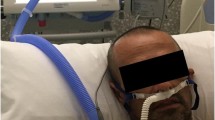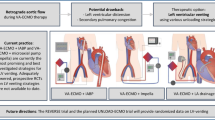Abstract
Purpose of the Review
Targeted pharmacotherapies did improve survival rates, exercise capacity, and quality of life (QoL) of PAH patients. However, these pharmacological interventions are expensive and not always accessible. In addition, not all patients do respond similarly to these medications and many will continue to deteriorate. This review aims to discuss the beneficial role of an artificial right-to-left shunt and highlights current interventional devices and outcomes.
Recent Findings
Since patients with preexisting atrial shunts or patients with Eisenmenger’s disease show better survival rates, improved exercise capacity, and QoL, PAH patients clinically do benefit from an atrial septostomy by reducing signs of right heart failure, improving left heart filling, cardiac output, and systemic oxygen transport despite hypoxia. However, an uncontrolled septostomy with unrestricted right-to-left shunt bears the risk of acute severe desaturation and death. The Atrial Flow Regulator (AFR device, Occlutech®, Sweden) provides an adjustable shunt size with restricted flow and excellent short-term outcomes.
Summary
Interventional strategies for PAH palliation are on the rise. The novel AFR device provides a durable and safe option for a controlled right-to-left shunting, thus enabling an individualized management.


Similar content being viewed by others
References
Papers of particular interest, published recently, have been highlighted as: • Of importance •• Of major importance
Galiè N, Humbert M, Vachiery JL, Gibbs S, Lang I, Torbicki A, et al. 2015 ESC/ERS guidelines for the diagnosis and treatment of pulmonary hypertension: the joint task force for the diagnosis and treatment of pulmonary hypertension of the European Society of Cardiology (ESC) and the European Respiratory Society (ERS): endorsed by: Association for European Pediatric and Congenital Cardiology (AEPC), International Society for Heart and Lung Transplantation (ISHLT). Eur Heart J. 2016 Jan 1;37(1):67–119.
Kostam MA, Kiernan MS, Bernstein D, Bozkurt B, Jacob M, Kapur NK, et al. Evaluation and management of right-sided heart failure: a scientific statement from the American Heart Association. Circulation. 2018;137(20):e578–622.
Burger CD, Ghandour M, Padmanabhan Menon D, Helmi H, Benza RL. Early intervention in the management of pulmonary arterial hypertension: clinical and economic outcomes. Clinicoecon Outcome Res. 2017;9:731–9.
Bhamra-Ariza P, Keogh AM, Muller DW. Percutaneous interventional therapies for the treatment of patients with severe pulmonary hypertension. J Am Coll Cardiol. 2014;63:611–8.
Benza RL, Miller DP, Gomberg-Maitland M, Frantz RP, Foreman AJ, Coffey CS, et al. Predicting survival in pulmonary arterial hypertension: insights from the registry to evaluate early and long-term pulmonary arterial hypertension disease management (REVEAL). Circulation. 2010;122(2):164–72.
Corris PA. Alternatives to lung transplantation: treatment of pulmonary arterial hypertension. Clin Chest Med. 2011;32(2):399–410.
Al Maluli H, DeStephan CM, Alvarez RJ Jr, Sandoval J. Atrial septostomy: a contemporary review. Clin Cardiol. 2015;38(6):395–400.
McLaughlin VV, Archer SL, Badesch DB, Barst RJ, Farber HW, Lindner JR, et al. ACCF/AHA 2009 epert consensus document on pulmonary hypertension a report oft he American College of Cardiology Foundation Task Force on Expert Consensus Documents and the American Heart Association developed in collaboration with the American College of Chest Physicians: American Thoracic Society, Inc.; and the Pulmonary Hypertension Association. J Am Coll Cardiol. 2009;53(17):1573–619.
Keogh AM, Mayer E, Benza RL, Corris P, Dartevelle PG, Frost AE, et al. Interventional and surgical modalities of treatment in pulmonary hypertension. J Am Coll Cardiol. 2009;54:S67–77.
•• Sandoval J, Go Keogh AM, Mayer E, Benza RL, Corris P, Dartevelle PG, et al. Interventional and surgical modalities of treatment in pulmonary hypertension. J Am Coll Cardiol. 2009;54:S67–77 This manuscript gives an excellent description of current and previous interventional strategies for PAH, hemodynamics, and outcomes.
Sandoval J, Gaspar J, Pena H, Santos LE, C_ordova J, del Valle K, et al. Effect of atrial septostomy on the survival of patients with severe pulmonary arterial hypertension. Eur Respir J. 2011;38:1343–8.
O’Byrne ML, Rosenzweig ES, Barst RJ. The effect of atrial septostomy on the concentration of brain-type natriuretic peptide in patients with idiopathic pulmonary arterial hypertension. Cardiol Young. 2007;17:557–9.
Allen HD, Shaddy RE, Penny DJ, Feltes TF, Cetta F. Moss & Adams’ heart disease in infants, children, and adolescents including the fetus and young adult (2 volume set). 9th ed. Philadelphia: Wolters Kluwer; 2016.
Schranz D, Michel-Behnke I. Advances in interventional and hybrid therapy in neonatal congenital heart disease. Semin Fetal Neonatal Med. 2013 Oct;18(5):311–21.
Veldtman GR, Norgard G, Wahlander H, Garty Y, Thabit O, McCrindle BW, et al. Creation and enlargement of atrial defects in congenital heart disease. Pediatr Cardiol. 2005;26(2):162–8.
Rozkovec A, Montanes P, Oakley CM. Factors that influence the outcome of primary pulmonary hypertension. Br Heart J. 1986;55(5):449–58.
Sun XG, Hansen JE, Oudiz RJ, Wasserman K. Gas exchange detection of exercise-induced right-to-left shunt in patients with primary pulmonary hypertension. Circulation. 2002;105(1):54–60.
Glanville AR, Burke CM, Theodore J, Robin ED. Primary pulmonary hypertension. Length of survival in patients referred for heart-lung transplantation. Chest. 1987;91(5):675–81.
Hopkins WE, Ochoa LL, Richardson GW, Trulock EP. Comparison of the hemodynamics and survival of adults with severe primary pulmonary hypertension or Eisenmenger syndrome. J Heart Lung Transplant. 1996;15:100–5.
D'Armini AM, Callegari G, Vitulo P, Klersy C, Rinaldi M, Pederzolli C, et al. Risk factors for early death in patients awaiting heart-lung or lung transplantation: experience at a single European center. Transplantation. 1998 Jul 15;66(1):123–7.
Vijarnsorn C, Durongpisitkul K, Chungsomprasong P, Bositthipichet D, Ketsara S, Titaram Y, et al. Contemporary survival of patients with pulmonary arterial hypertension and congenital systemic to pulmonary shunts. PLoS One. 2018;13(4):e0195092.
Bonello B, Renard S, Mancini J, Hubert S, Habib G, Fraisse A. Life span of patients with Eisenmenger syndrome is not superior to that of patients with other causes of pulmonary hypertension. Cardiovasc Diagn Ther. 2014;4(5):341–9.
Manes A, Palazzini M, Leci E, Bacchi Reggiani ML, Branzi A, Galiè N. Current era survival of patients with pulmonary arterial hypertension associated with congenital heart disease: a comparison between clinical subgroups. Eur Heart J. 2014;35(11):716–24.
Austen WG, Morrow AG, Berry WB. Experimental studies of the surgical treatment of primary pulmonary hypertension. J Thorac Cardiovasc Surg. 1964;48:448–55.
Rashkind WJ, Miller WW. Creation of an atrial septal defect without thoracotomy. A palliative approach to complete transposition of the great arteries. JAMA. 1996;196(11):991–2.
Park SC, Neches WH, Zuberbuhler JR, Lenox CC, Mathews RA, Fricker FJ, et al. Clinical use of blade atrial septostomy. Circulation. 1978;58(4):600–6.
Park SC, Neches WH, Mullins CE, Girod DA, Olley PM, Falkowski G, et al. Blade atrial septostomy: collaborative study. Circulation. 1982;6682:258–66.
Rich S, Lam W. Atrial septostomy as palliative therapy for refractory primary pulmonary hypertension. Am J Cardiol. 1983;51(9):1560–1.
Hausknecht MJ, Sims RE, Nihill MR, Cashion WR. Successful palliation of primary pulmonary hypertension by atrial septostomy. Am J Cardiol. 1990;65(15):1045–6.
Nihill MR, O'Laughlin MP, Mullins CE. Effects of atrial septostomy in patients with terminal cor pulmonale due to pulmonary vascular disease. Catheter Cardiovasc Diagn. 1991;24(3):166–72.
Kerstein D, Levy PS, Hsu DT, Hordof AJ, Gersony WM, Barst RJ. Blade balloon atrial septostomy in patients with severe primary pulmonary hypertension. Circulation. 1995;91(7):2028–35.
Sandoval J, Gaspar J, Pulido T, Bautista E, Martínez-Guerra ML, Zeballos M, et al. Graded balloon dilation atrial septostomy in severe primary pulmonary hypertension. A therapeutic alternative for patients nonresponsive to vasodilator treatment. Am Coll Cardiol. 1998;32(2):297–304.
Bauer A, Khalil M, Schmidt D, Bauer J, Esmaeili A, Apitz C, et al. Creation of a restrictive atrial communication in pulmonary arterial hypertension (PAH): effective palliation of syncope and end-stage heart failure. Pulm Circ. 2018;8(2):2045894018776518.
Sandoval J. Interventional therapies in pulmonary hypertension. Rev Esp Cardiol (Engl Ed). 2018;71(7):565–74.
Kurzyna M, Dabrowski M, Bielecki D, Fijalkowska A, Pruszczyk P, Opolski G, et al. Atrial septostomy in treatment of end-stage right heart failure in patients with pulmonary hypertension. Chest. 2007;131(4):977–83.
Vachiery JL, Stoupel E, Boonstra A, Naeije R. Balloon atrial septostomy for pulmonary hypertension in the prostacyclin era. Am J Respir Crit Care Med. 2003;167:A692.
Allcock RJ, O’Sullivan JJ, Corris PA. Atrial septostomy for pulmonary hypertension. Heart. 2003;89(11):1344–7.
Troost E, Delcroix M, Gewillig M, Van Deyk K, Budts W. A modified technique of stent fenestration of the interatrial septum improves patients with pulmonary hypertension. Catheter Cardiovasc Interv. 2009;73(2):173–9.
D'Alonzo GE, Barst RJ, Ayres SM, Bergofsky EH, Brundage BH, Detre KM, et al. Survival in patients with primary pulmonary hypertension. Results from a national prospective registry. Ann Intern Med. 1991;115(5):343–9.
Espinola-Zavaleta N, Vargas-Barr_on J, Tazar JI, Casanova JM, Keirns C, Cardenas AR, et al. Echocardiographic evaluation of patients with primary pulmonary hypertension before and after atrial septostomy. Echocardiography. 1999;16:625–34.
. Rajeshkumar R, Pavithran S, Sivakumar K, Vettukattil JJ. Atrial septostomy with a predefined diameter using a novel occlutech atrial flow regulator improves symptoms and cardiac index in patients with severe pulmonary arterial hypertension. Catheter Cardiovasc Interv. 2017;90(7):1145–53 This manuscript describes the first 12 PAH patients who received an AFR® device with excellent short-term outcome.
Malaczynksa-Rajpold K, Araskiewicz A, Mularek-Kubzdela T. Balloon atrial septostomy in pulmonary arterial hypertension: a beneficial effect on the control of rhythm abnormalities. Cardiol J. 2016;23(5):539–40.
Micheletti A, Hislop AA, Lammers A, Bonhoeffer P, Derrick G, Rees P, et al. Role of atrial septostomy in the treatment of children with pulmonary arterial hypertension. Heart. 2006;92(7):969–72.
Fraisse A, Chetaille P, Amin Z, Rouault F, Humbert M. Use of Amplatzer fenestrated atrial septal defect device in a child with familial pulmonary hypertension. Pediatr Cardiol. 2006;27(6):759–62.
O'Loughlin AJ, Keogh A, Muller DW. Insertion of a fenestrated Amplatzer atrial septostomy device for severe pulmonary hypertension. Heart Lung Circ. 2006;15(4):275–7.
Lammers AE, Derrick G, Haworth SG, Bonhoeffer P, Yates R. Efficacy and long-term patency of fenestrated Amplatzer devices in children. Catheter Cardiovasc Interv. 2007;70:578–84.
Prieto LR, Latson LA, Jennings C. Atrial septostomy using a butterfly stent in a patient with severe pulmonary arterial hypertension. Catheter Cardiovasc Interv. 2006 Oct;68(4):642–7.
Roy AK, Gaine SP, Walsh KP. Percutaneous atrial septostomy with modified butterfly stent and intracardiac echocardiographic guidance in a patient with syncope and refractory pulmonary arterial hypertension. Heart Lung Circ. 2013;22(8):668–71. https://doi.org/10.1016/j.hlc.2013.01.005.
Aldoss O, Reinking BE, Divekar A. Native atrial septal restriction after Fontan palliation successfully treated with transcatheter diabolo stent. Ann Pediatr Cardiol. 2016;9(1):49–52. https://doi.org/10.4103/0974-2069.171411.
Aldoss O, Divekar A. Modified technique to create diabolo stent configuration. Pediatr Cardiol. 2016;37(4):728–33. https://doi.org/10.1007/s00246-015-1339-6.
Anderson B, Bhole V, Desai T, Mehta C, Stumper O. Novel technique to reduce the size of a Fontan diabolo stent fenestration. Catheter Cardiovasc Interv. 2010;76(6):860–4. https://doi.org/10.1002/ccd.22661.
Stümper O, Gewillig M, Vettukattil J, Budts W, Chessa M, Chaudhari M, et al. Modified technique of stent fenestration of the atrial septum. Heart. 2003;89(10):1227–30.
Sabiniewicz R. Baloon atrial septostomy in pulmonary hypertension: atrial flow regulator – new therapeutic option. Cardiol J. 2017;24:455–6.
. Patel MB, Samuel BP, Girgis RE, Parlmer MA, Vettukattil JJ. Implantable atrial flow regulator for severe, irreversible pulmonary arterial hypertension. EuroIntervention. 2015;11(6):706–9 This paper describes the first in-man implantation of an AFR® device.
Lehner A, Schulze-Neick I, Haas NA. Creation of a defined and stable Fontan fenestration with the new Occlutech Atrial Flow Regulator (AFR®). Cardiol Young. 2018;28(8):1062–6 This manuscript ties an excellent example of the use of the AFR-device in Fontan-patients.
Manuri L, Calaciura RE, De Zorzi A, Oreto L, Raponi M, Lehner A, et al. Atrial flow regulator for failing Fontan circulation: an initial European experience. Interact Cardiovasc Thorac Surg. 2018;27:761–4.
Hopkins WE. The remarkable right ventricle of patients with Eisenmenger syndrome. Coron Artery Dis. 2005;16(1):19–25.
Author information
Authors and Affiliations
Corresponding author
Ethics declarations
Conflict of Interest
Nikolaus A. Haas works as consultant and proctor for Occlutech. Anja Lehner, Ingram Schulze-Neick, Marcus Fischer, Silvia Fernandez Rodriguez, Sarah Ulrich, and André Jakob declare that they have no conflict of interest.
Human and Animal Rights and Informed Consent
This article does not contain any studies with animals or human participants performed by any of the authors.
Additional information
Publisher’s Note
Springer Nature remains neutral with regard to jurisdictional claims in published maps and institutional affiliations.
This article is part of the Topical Collection on Structural Heart Disease
Rights and permissions
About this article
Cite this article
Lehner, A., Schulze-Neick, I., Fischer, M. et al. The Creation of an Interatrial Right-To-Left Shunt in Patients with Severe, Irreversible Pulmonary Hypertension: Rationale, Devices, Outcomes. Curr Cardiol Rep 21, 31 (2019). https://doi.org/10.1007/s11886-019-1118-8
Published:
DOI: https://doi.org/10.1007/s11886-019-1118-8




